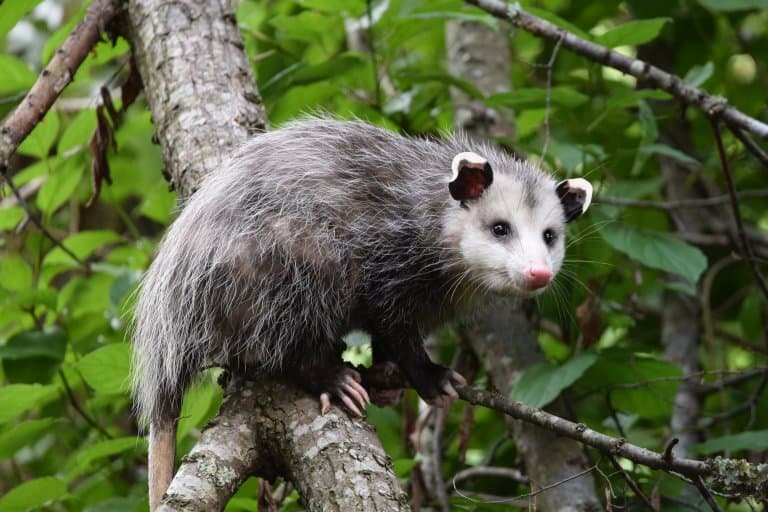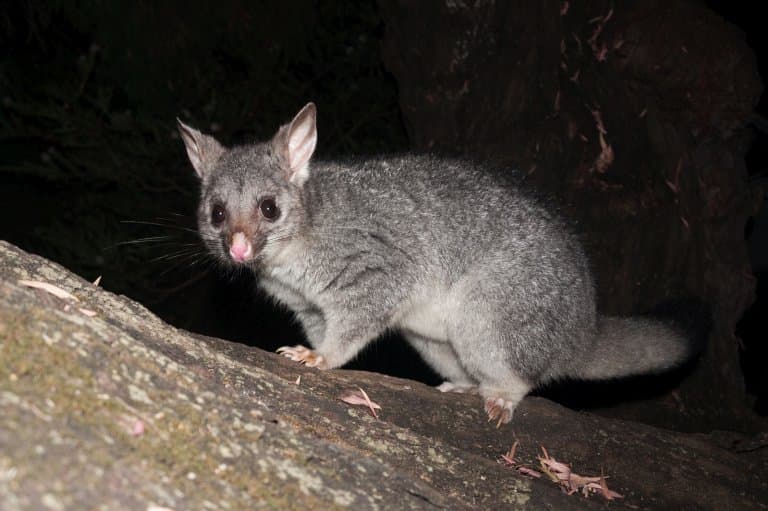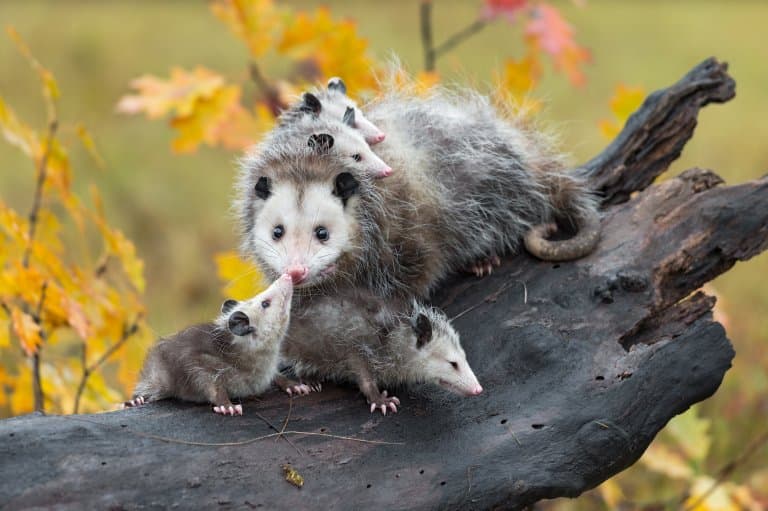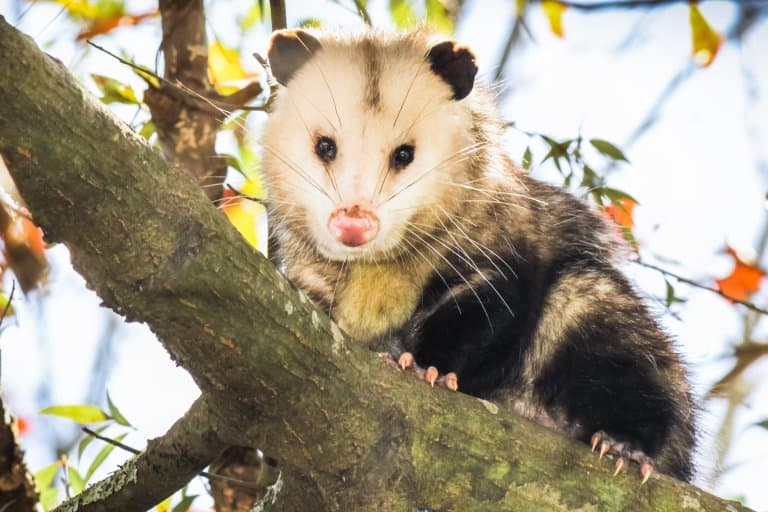Opossum Profile
Marsupials are thought to have originated in North America, migrating South, crossing via Antarctica into Australia, where almost all extant species remain today, having been isolated when the continents shifted.
Placental mammals outcompeted these more primitive evolutionary experiments on every other continent. In the US and Canada, this meant the extinction of all native marsupials but one: the Opossum.
Opossums are typically semi-arboreal, opportunistic omnivores, that grow to around the size of a house cat and have long snouts.

Opossum Facts Overview
| Habitat: | Forests, swamps, shrubland |
| Location: | The Americas |
| Lifespan: | 2-4 years |
| Size: | Up to a meter long in Didelphis virginiana |
| Weight: | No more than 3kg (6.6lb) |
| Color: | Usually grey or brown, dappled with white |
| Diet: | Everything |
| Predators: | Humans, coyotes |
| Top Speed: | Slow |
| No. of Species: |
93 |
| Conservation Status: |
Least Concern to Vulnerable, depending on species (IUCN) |
Opossums – distinct from the Australian and New Guinea “Possums” – make up almost 100 species across 18 genera, distributed mainly across South America.
While all opossums are considered omnivores, the different species can be diverse in their diet. Some will eat more animals, while others will focus more on vegetation. They will eat dead animals, insects, birds, frogs, fruits and plants.
They’re also one of the most unfairly disrespected animals on the planet, often considered vermin, aggressive, and dirty.
In reality, they’re incredibly delicious, adaptive, simple, and sweet animals who also provide valuable clean-up services. They also have a very convincing mimicry named after them.
But their long forages and unusual physiology make them unsuitable as pets and when brought indoors, they can become a health hazard.
Interesting Opossum Facts
1. They are not the same as ‘possums’
The word ‘possum’ is often used by Americans to describe the Virginia opossum species, which is found across the US, and Canada.
However, this should not be confused with the Australasian ‘possum‘, which is a marsupial of the same name – but is from a completely different order, and therefore not closely related.
The name ‘possum’ is thought to have come from their semi-resemblance to the opossum just to confuse matters further, though they are more closely related to the kangaroo.

2. Possum and ‘Taters
Opossums make up a significant proportion of 19th Century American “Southern-Style” cuisine, and in some niche circles continue to be at least a tongue-in-cheek delicacy to this day, with one gruesomely detailed poem suggesting:
“Once the creature acquires a fat lazy manner, hit it center cranium with a hatchet or hammer, which may require additional blows until the skull pops and the brain is exposed (don’t assume it’s dead because its eyes are closed).”
It goes on to instruct the cook how to turn the animal inside out and prepare it for broiling, using the axle from a John Deere Tractor as a kebab stick.
Opossums are eaten on Caribbean islands too and is so sought-after that hunting restrictions are now in place to make sure they don’t disappear entirely.
But there’s so much more to these animals than their delicious flavour. 1
3. They’re tough!
Not only can opossums thrive in rough environments – which is why many species are so commonly found around people – They’re also highly resilient to rabies and animal venoms.
Large species appear to have a high tolerance for rattlesnake venom, allowing them to get bitten without incident. This is handy for those species that commonly eat snakes, including copperheads and rattlesnakes.
They also have a natural resistance to rabies, which makes them relatively immune, and this comes from having an exceptionally low internal temperature that’s below the optimum range for the virus.
So, opossums aren’t great vectors of disease, and they’re actually good at pest control, too.

5. They’re tick removal machines
Opossums may significantly reduce the spread of Lyme disease by devouring ticks en masse.
A single possum can gulp down 5,000 ticks in a season, chowing down on the would-be parasites as they attempt to latch onto the opossum.
They’ll also munch on other disease vectors like cockroaches and mice.
Throughout its foraging hours, the opossum will eat almost anything, which is one of the attributes that has led to its widespread success on the American continents.
Like foxes and raccoons, opossums are generalists and have outlasted all of their marsupial cousins. 2
6. They’re living fossils
Opossums represent a lineage of small mammals that split from the Australian marsupials right after the time of the dinosaur extinction.
They’re one of the more primitive mammalian phenotypes and a lasting member of the incredible early radiation of species that occurred when previously-occupied niches opened up after most dinosaurs disappeared.
As such, they share one of the closest resemblances to prehistoric mammals there is today, and have survived, relatively unchanged, where countless thousands of species didn’t.
6. They’re very good at playing possum
When cornered, opossums will hiss and show their teeth and can look very menacing, though possum bites are very uncommon.
What’s far more likely if the threats don’t work is that the animal will play dead.
They’re so good at this act, they’ll even make a show of looking sick before collapsing, suggesting that they carry disease or are otherwise a bad choice to eat.
More than this, they can even froth at the mouth and release a perturbing aroma of decaying flesh.
This entire process isn’t much of an act. In fact, they have no control over it at all. It’s a reflexive response to intense fear – one which can last for hours.
Since there are still some animals who would be happy to eat a rotting opossum corpse, it’s not a good idea to trigger this response for fun as it could put them in danger! 3 4
7. Some species have prehensile tales
This is a tail that is used for grasping or holding branches, and allows them to hang from trees – like some new world monkey species.
However, dangling from a tree is often seen more in young, juvenile opossums rather than adults.
This useful tail is often used as a fifth limb when climbing, and to help carry nesting, or leaves.
8. They are a bit lazy
Opossums are often solitary and nomadic, and will live and forage alone and stay in one place where there is a food and water source.
They will sometimes group together in small families, but rather than dig their own burrow, they will just occupy abandoned burrows or shelter in under houses.
They can also sleep for over 20 hours a day and prefer not to explore much. They made our laziest animals in the world list!

9. They can make great friends
Despite their reputation – early colonisers of the American continent described them as having the head of a swine and the tail of a rat – opossums are well known by those who keep them as being docile, friendly animals.
They’re also affectionate pets and display this affection by way of sliming, in which they’ll lick faces and rub their heads on their owners to show them some love.
In spite of this, there are plenty of reasons why keeping pet opossums is a bad idea.
10. We probably shouldn’t keep them as pets
While they’re good at pest control in the wild, they’re still capable of carrying certain parasites that may be unhealthy to humans.
They’re also quite unusual pets with a massive stigma against them, making vet trips very difficult. These are wild animals, and rescuers commonly report difficulties in providing them with their basic needs.
The foraging behaviour of an opossum may take it across a 50-hectare territory in the wild; something which is almost impossible to replicate in a captive environment.

Opossum Fact-File Summary
Scientific Classification
| Kingdom: | Animalia |
| Phylum: | Chordata |
| Class: | Mammalia |
| Order: | Didelphimorphia |
| Family: | Didelphidae |
Fact Sources & References
- Charlese Hunter (1900), “Possum and taters: Ragtime feast”,H.A. French, Nashville.
- JANE KIRCHNER (2021), “Opossums: Unsung Heroes in the Fight Against Ticks and Lyme Disease”, NWF Blog.
- (2019), “Opossums Can’t Actually Choose When To Play Dead”, J&J Exterminating Co.
- (2018), “Possum Playing Dead”, Youtube.
